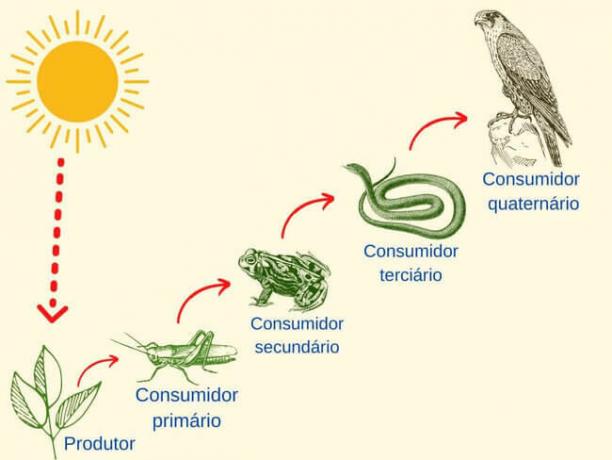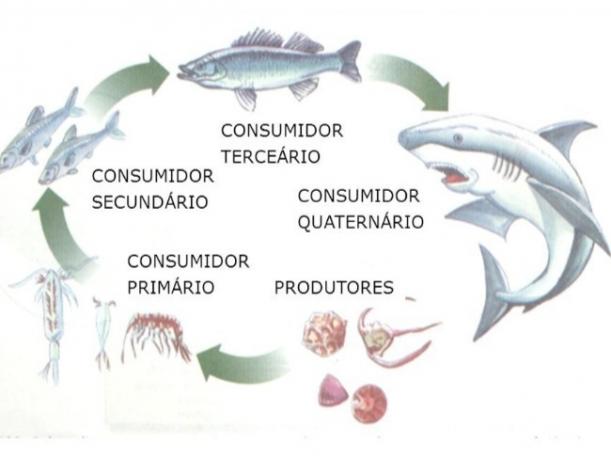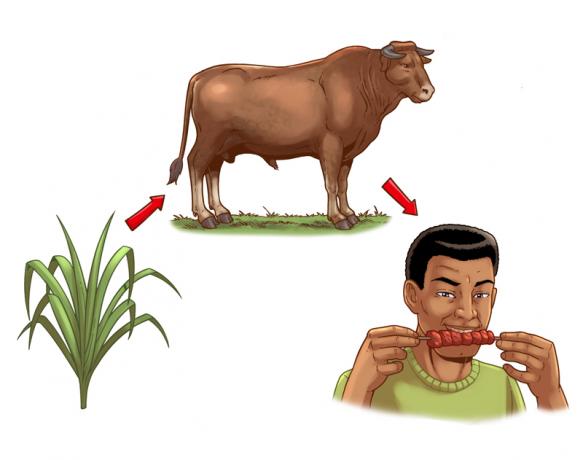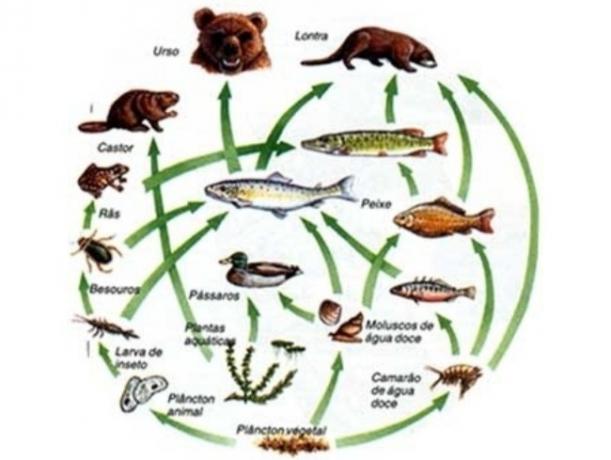Food chain is the sequence of food between living beings, in which one feeds on the other, ensuring its survival.
From the beings that produce their own food and generate energy, a sequence (chain) is developed in which a living being is consumed by another. The last animal in this chain, after its death, will serve as food for the decomposing organisms, ending the cycle.
Each part of this chain is called the trophic level (food level). Every time a living being feeds the energy of food has a part used in the form of calories and another part transferred to its consumer. The original energy is lost at the time of each transfer.
The energy of food begins with the producing beings (autotrophs) that generate the energy. The second trophic level is composed of consumers (heterotrophs): primary, secondary, tertiary and quaternary consumers. The last trophic level is formed by decomposing beings that feed on organic matter.

Examples of food chains
Food chains are represented according to the ecosystem. In this case, the main types are:
aquatic food chain

In aquatic ecosystems, the main producers are the phylloplankton, which are a set of unicellular and microscopic algae that carry out photosynthesis.
As primary consumers are the zooplankton (protozoa, worms, crustaceans, etc.), organisms that feed on phylloplankton or some types of bacteria.
Zooplankton, in turn, serve as food for fish, and so on.
terrestrial food chain

As the image illustrates, in the terrestrial food chain we have plants as producers that, due to their instead, they serve as food for primary consumers (herbivores or omnivores), represented by the Locust.
Decomposers (fungi and bacteria) appear at the end of the cycle, but they can act at any trophic level, starting from the decomposition of dead organic matter. This is a fundamental activity to guarantee the balance of the ecosystem and the life cycle.
human food chain

O human being is omnivorous, that is, it feeds on both plants and meat. In this case, it can be classified as a primary, secondary or tertiary consumer, according to the food it consumes.
For example, man is a secondary consumer when he eats beef, since this animal, when alive, fed on grass, that is, it acted as a primary consumer.
Trophic levels in a food chain
The food chain is made up of three main groups of living beings: producers, consumers and decomposers.
Each of them represents a trophic level of energy flow transmitted through food. The first trophic level is formed by the producers and the last one is the decomposers.
Producers
This is the first trophic level in the food chain. Producers are those who produce their own food (autotrophs), either through photosynthesis or chemosynthesis.
Plants and plankton are the main examples of producing organisms, as they use nutrients from the soil and sunlight to obtain energy in a self-sufficient way.
The producing organisms will always be the base of the food chain and the beings with the greatest amount of energy.
Learn more about autotrophs.
Consumers
It's all living beings that need to feed from another for energy and nutrients (heterotrophs).
Within the consumer group there are different classifications:
- Primary Consumers: are all organisms that feed directly from the Producers. In this case, they are usually herbivorous or omnivorous animals, as they consume plants. Examples: rabbit and cow.
- Secondary Consumers: it is the living beings that feed on the primary consumers. Are carnivores or omnivores. Example: human and cat.
- Tertiary Consumers: it is the organisms that consume the secondary ones. They can also be carnivores or omnivores. Example: lion and shark.
Trophic levels can continue successively, but as energy is lost with each new transmission, there are usually not many consumption stages in a food chain.
Learn more about heterotrophs.
Decomposers
Finally, in the last trophic phase of the food chain, there are decomposers. These are beings that decomposes dead organic matter, remove the nutrients they need to survive, and return to the environment what is needed to restart the cycle.
Even belonging to the last trophic level of the food chain, decomposers are present at all other levels. For example, when an animal that is a primary consumer dies, the decomposing organisms act to decompose its organic matter. The same happens if a secondary or tertiary person dies.
Bacteria and fungi are some examples of decomposing organisms present in most ecosystems.
food chain and food web
The difference between them is that the food chain is a linear and unidirectional sequence that indicates which living being serves as food for another.
The food web is the set of various food chains, presenting in a more complex way the reality of the existing feeding relationships in ecosystems.

The food web is graphically represented with a large number of living beings, revealing a set of food chains with arrows that indicate who consumes whom. The arrows in this set of food chains make it look like a spider's web, and that's why the name "food web" came up.
Thus, in the food web we see that the same organism can be present at different trophic levels, whether as a primary consumer, as well as a secondary or tertiary consumer. In this way, it is possible to follow all the different paths that energy can pass through the ecosystem.
Learn more about food web.
Crisis in the food chain
Ecosystem imbalance is one of the main environmental problems of our time. With the extinction of some animal and plant species, there are increasing problems in food chains and, consequently, damage to the ecosystem.
Predatory hunting of animals, water and air pollution and river contamination are the factors that directly influence the food chain.
Learn more about the meaning of ecosystem.
